complexType
Section
element Section/UniqueSectionCode
element Section/SequenceOfCourse
element Section/EducationalEnvironment
element Section/MediumOfInstruction
element Section/PopulationServed
element Section/AvailableCredit
element Section/SectionCharacteristics
element Section/CourseOfferingReference
element Section/SchoolReference
element Section/SessionReference
element Section/LocationReference
element Section/ClassPeriodReference
element Section/ProgramReference
| diagram |  |
||||||||||||||
| namespace | http://ed-fi.org/0110 | ||||||||||||||
| type | extension of ComplexObjectType | ||||||||||||||
| properties |
|
||||||||||||||
| children | UniqueSectionCode SequenceOfCourse EducationalEnvironment MediumOfInstruction PopulationServed AvailableCredit SectionCharacteristics CourseOfferingReference SchoolReference SessionReference LocationReference ClassPeriodReference ProgramReference | ||||||||||||||
| attributes |
|
||||||||||||||
| annotation |
|
||||||||||||||
| source | <xs:complexType name="Section"> <xs:annotation> <xs:documentation>This educational entity represents a setting in which organized instruction of course content is provided to one or more students for a given period of time. A course may be offered to more than one class/section. Instruction, provided by one or more teachers or other staff members, may be delivered in person or via a different medium. </xs:documentation> <xs:appinfo> <ann:TypeGroup>Domain Entity</ann:TypeGroup> </xs:appinfo> </xs:annotation> <xs:complexContent> <xs:extension base="ComplexObjectType"> <xs:sequence> <xs:element name="UniqueSectionCode" type="UniqueSectionCode"> <xs:annotation> <xs:documentation>A unique identifier for the section that is defined by the classroom, the subjects taught, and the instructors that are assigned.</xs:documentation> </xs:annotation> </xs:element> <xs:element name="SequenceOfCourse" type="SequenceOfCourse"> <xs:annotation> <xs:documentation>When a section is part of a sequence of parts for a course, the number if the sequence. If the course has only one part, the value of this section attribute should be 1.</xs:documentation> </xs:annotation> </xs:element> <xs:element name="EducationalEnvironment" type="EducationalEnvironmentType" minOccurs="0"> <xs:annotation> <xs:documentation>The setting in which a child receives education and related services; for example: Center-based instruction Home-based instruction Hospital class Mainstream Residential care and treatment facility ....</xs:documentation> </xs:annotation> </xs:element> <xs:element name="MediumOfInstruction" type="MediumOfInstructionType" minOccurs="0"> <xs:annotation> <xs:documentation>The media through which teachers provide instruction to students and students and teachers communicate about instructional matters; for example: Technology-based instruction in classroom Correspondence instruction Face-to-face instruction Virtual/On-line Distance learning Center-based instruction ...</xs:documentation> </xs:annotation> </xs:element> <xs:element name="PopulationServed" type="PopulationServedType" minOccurs="0"> <xs:annotation> <xs:documentation>The type of students the section is offered and tailored to; for example: Bilingual students Remedial education students Gifted and talented students Career and Technical Education students Special education students ....</xs:documentation> </xs:annotation> </xs:element> <xs:element name="AvailableCredit" type="Credits" minOccurs="0"> <xs:annotation> <xs:documentation>The amount of credit available to a student who successfully meets the objectives of the course. Available credits are measured in Carnegie units, A course meeting every day for one period of the school day over the span of a school year offers one Carnegie unit. See publication: U.S. Department of Education, NCES, 2007-341, Secondary School Course Classification System: School Codes for the Exchange of Data (SCED).</xs:documentation> </xs:annotation> </xs:element> <xs:element name="SectionCharacteristics" type="DescriptorReferenceType" minOccurs="0" maxOccurs="unbounded"> <xs:annotation> <xs:documentation>Reflects important characteristics of the section, such as whether or not attendance is taken and the section is graded.</xs:documentation> <xs:appinfo> <ann:Descriptor>SectionCharacteristicsDescriptor</ann:Descriptor> </xs:appinfo> </xs:annotation> </xs:element> <xs:element name="CourseOfferingReference" type="CourseOfferingReferenceType"> <xs:annotation> <xs:documentation>The course offering taught in the section.</xs:documentation> </xs:annotation> </xs:element> <xs:element name="SchoolReference" type="EducationOrganizationReferenceType"> <xs:annotation> <xs:documentation>The school where the section is taught.</xs:documentation> </xs:annotation> </xs:element> <xs:element name="SessionReference" type="SessionReferenceType" minOccurs="0"> <xs:annotation> <xs:documentation>The session associated with the session. This reference is optional only if the session reference is available elsewhere in the interchange.</xs:documentation> </xs:annotation> </xs:element> <xs:element name="LocationReference" type="LocationReferenceType" minOccurs="0"> <xs:annotation> <xs:documentation>The location, typically a classroom, where the section meets.</xs:documentation> </xs:annotation> </xs:element> <xs:element name="ClassPeriodReference" type="ClassPeriodReferenceType" minOccurs="0"> <xs:annotation> <xs:documentation>The class period during which the section meets.</xs:documentation> </xs:annotation> </xs:element> <xs:element name="ProgramReference" type="ProgramReferenceType" minOccurs="0" maxOccurs="unbounded"> <xs:annotation> <xs:documentation>Optional reference to program (e.g., CTE) to which the section is associated.</xs:documentation> </xs:annotation> </xs:element> </xs:sequence> </xs:extension> </xs:complexContent> </xs:complexType> |
element Section/UniqueSectionCode
| diagram |  |
|||||||||
| namespace | http://ed-fi.org/0110 | |||||||||
| type | UniqueSectionCode | |||||||||
| properties |
|
|||||||||
| facets |
|
|||||||||
| annotation |
|
|||||||||
| source | <xs:element name="UniqueSectionCode" type="UniqueSectionCode"> <xs:annotation> <xs:documentation>A unique identifier for the section that is defined by the classroom, the subjects taught, and the instructors that are assigned.</xs:documentation> </xs:annotation> </xs:element> |
element Section/SequenceOfCourse
| diagram |  |
|||||||||
| namespace | http://ed-fi.org/0110 | |||||||||
| type | SequenceOfCourse | |||||||||
| properties |
|
|||||||||
| facets |
|
|||||||||
| annotation |
|
|||||||||
| source | <xs:element name="SequenceOfCourse" type="SequenceOfCourse"> <xs:annotation> <xs:documentation>When a section is part of a sequence of parts for a course, the number if the sequence. If the course has only one part, the value of this section attribute should be 1.</xs:documentation> </xs:annotation> </xs:element> |
element Section/EducationalEnvironment
| diagram | 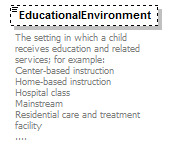 |
||||||||||||||||||||||||||||||||||||||||||
| namespace | http://ed-fi.org/0110 | ||||||||||||||||||||||||||||||||||||||||||
| type | EducationalEnvironmentType | ||||||||||||||||||||||||||||||||||||||||||
| properties |
|
||||||||||||||||||||||||||||||||||||||||||
| facets |
|
||||||||||||||||||||||||||||||||||||||||||
| annotation |
|
||||||||||||||||||||||||||||||||||||||||||
| source | <xs:element name="EducationalEnvironment" type="EducationalEnvironmentType" minOccurs="0"> <xs:annotation> <xs:documentation>The setting in which a child receives education and related services; for example: Center-based instruction Home-based instruction Hospital class Mainstream Residential care and treatment facility ....</xs:documentation> </xs:annotation> </xs:element> |
element Section/MediumOfInstruction
| diagram | 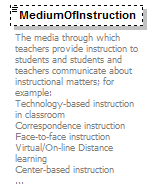 |
|||||||||||||||||||||||||||||||||||||||
| namespace | http://ed-fi.org/0110 | |||||||||||||||||||||||||||||||||||||||
| type | MediumOfInstructionType | |||||||||||||||||||||||||||||||||||||||
| properties |
|
|||||||||||||||||||||||||||||||||||||||
| facets |
|
|||||||||||||||||||||||||||||||||||||||
| annotation |
|
|||||||||||||||||||||||||||||||||||||||
| source | <xs:element name="MediumOfInstruction" type="MediumOfInstructionType" minOccurs="0"> <xs:annotation> <xs:documentation>The media through which teachers provide instruction to students and students and teachers communicate about instructional matters; for example: Technology-based instruction in classroom Correspondence instruction Face-to-face instruction Virtual/On-line Distance learning Center-based instruction ...</xs:documentation> </xs:annotation> </xs:element> |
element Section/PopulationServed
| diagram | 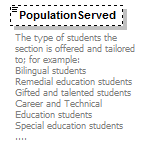 |
|||||||||||||||||||||||||||||||||
| namespace | http://ed-fi.org/0110 | |||||||||||||||||||||||||||||||||
| type | PopulationServedType | |||||||||||||||||||||||||||||||||
| properties |
|
|||||||||||||||||||||||||||||||||
| facets |
|
|||||||||||||||||||||||||||||||||
| annotation |
|
|||||||||||||||||||||||||||||||||
| source | <xs:element name="PopulationServed" type="PopulationServedType" minOccurs="0"> <xs:annotation> <xs:documentation>The type of students the section is offered and tailored to; for example: Bilingual students Remedial education students Gifted and talented students Career and Technical Education students Special education students ....</xs:documentation> </xs:annotation> </xs:element> |
element Section/AvailableCredit
| diagram | 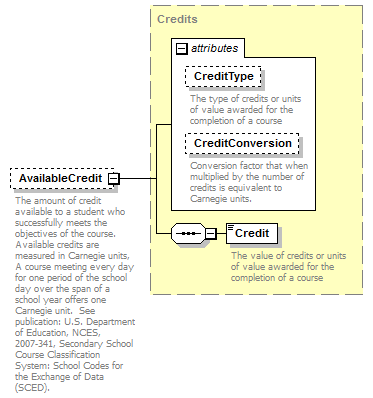 |
||||||||||||||||||||||
| namespace | http://ed-fi.org/0110 | ||||||||||||||||||||||
| type | Credits | ||||||||||||||||||||||
| properties |
|
||||||||||||||||||||||
| children | Credit | ||||||||||||||||||||||
| attributes |
|
||||||||||||||||||||||
| annotation |
|
||||||||||||||||||||||
| source | <xs:element name="AvailableCredit" type="Credits" minOccurs="0"> <xs:annotation> <xs:documentation>The amount of credit available to a student who successfully meets the objectives of the course. Available credits are measured in Carnegie units, A course meeting every day for one period of the school day over the span of a school year offers one Carnegie unit. See publication: U.S. Department of Education, NCES, 2007-341, Secondary School Course Classification System: School Codes for the Exchange of Data (SCED).</xs:documentation> </xs:annotation> </xs:element> |
element Section/SectionCharacteristics
| diagram | 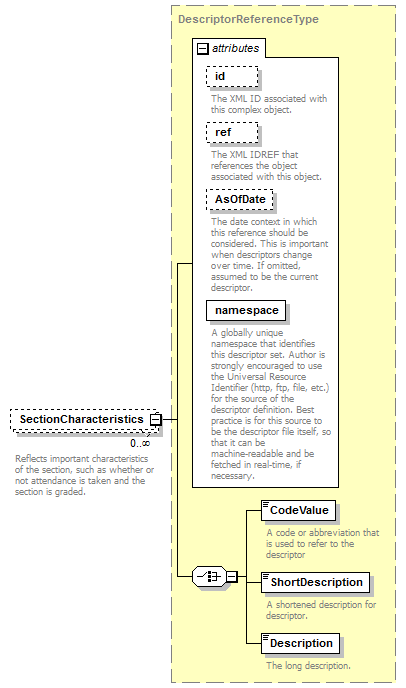 |
||||||||||||||||||||||||||||||||||||||
| namespace | http://ed-fi.org/0110 | ||||||||||||||||||||||||||||||||||||||
| type | DescriptorReferenceType | ||||||||||||||||||||||||||||||||||||||
| properties |
|
||||||||||||||||||||||||||||||||||||||
| children | CodeValue ShortDescription Description | ||||||||||||||||||||||||||||||||||||||
| attributes |
|
||||||||||||||||||||||||||||||||||||||
| annotation |
|
||||||||||||||||||||||||||||||||||||||
| source | <xs:element name="SectionCharacteristics" type="DescriptorReferenceType" minOccurs="0" maxOccurs="unbounded"> <xs:annotation> <xs:documentation>Reflects important characteristics of the section, such as whether or not attendance is taken and the section is graded.</xs:documentation> <xs:appinfo> <ann:Descriptor>SectionCharacteristicsDescriptor</ann:Descriptor> </xs:appinfo> </xs:annotation> </xs:element> |
element Section/CourseOfferingReference
| diagram | 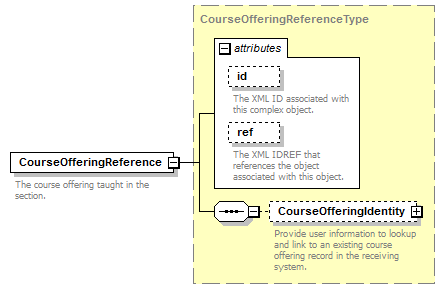 |
||||||||||||||||||||||
| namespace | http://ed-fi.org/0110 | ||||||||||||||||||||||
| type | CourseOfferingReferenceType | ||||||||||||||||||||||
| properties |
|
||||||||||||||||||||||
| children | CourseOfferingIdentity | ||||||||||||||||||||||
| attributes |
|
||||||||||||||||||||||
| annotation |
|
||||||||||||||||||||||
| source | <xs:element name="CourseOfferingReference" type="CourseOfferingReferenceType"> <xs:annotation> <xs:documentation>The course offering taught in the section.</xs:documentation> </xs:annotation> </xs:element> |
element Section/SchoolReference
| diagram |  |
||||||||||||||||||||||
| namespace | http://ed-fi.org/0110 | ||||||||||||||||||||||
| type | EducationOrganizationReferenceType | ||||||||||||||||||||||
| properties |
|
||||||||||||||||||||||
| children | EducationOrganizationIdentity | ||||||||||||||||||||||
| attributes |
|
||||||||||||||||||||||
| annotation |
|
||||||||||||||||||||||
| source | <xs:element name="SchoolReference" type="EducationOrganizationReferenceType"> <xs:annotation> <xs:documentation>The school where the section is taught.</xs:documentation> </xs:annotation> </xs:element> |
element Section/SessionReference
| diagram |  |
||||||||||||||||||||||
| namespace | http://ed-fi.org/0110 | ||||||||||||||||||||||
| type | SessionReferenceType | ||||||||||||||||||||||
| properties |
|
||||||||||||||||||||||
| children | SessionIdentity | ||||||||||||||||||||||
| attributes |
|
||||||||||||||||||||||
| annotation |
|
||||||||||||||||||||||
| source | <xs:element name="SessionReference" type="SessionReferenceType" minOccurs="0"> <xs:annotation> <xs:documentation>The session associated with the session. This reference is optional only if the session reference is available elsewhere in the interchange.</xs:documentation> </xs:annotation> </xs:element> |
element Section/LocationReference
| diagram |  |
||||||||||||||||||||||
| namespace | http://ed-fi.org/0110 | ||||||||||||||||||||||
| type | LocationReferenceType | ||||||||||||||||||||||
| properties |
|
||||||||||||||||||||||
| children | LocationIdentity | ||||||||||||||||||||||
| attributes |
|
||||||||||||||||||||||
| annotation |
|
||||||||||||||||||||||
| source | <xs:element name="LocationReference" type="LocationReferenceType" minOccurs="0"> <xs:annotation> <xs:documentation>The location, typically a classroom, where the section meets.</xs:documentation> </xs:annotation> </xs:element> |
element Section/ClassPeriodReference
| diagram | 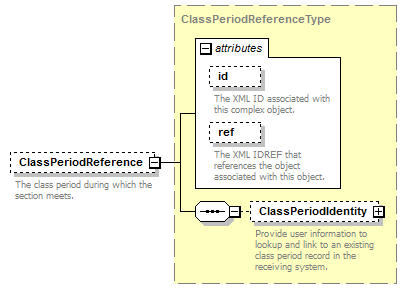 |
||||||||||||||||||||||
| namespace | http://ed-fi.org/0110 | ||||||||||||||||||||||
| type | ClassPeriodReferenceType | ||||||||||||||||||||||
| properties |
|
||||||||||||||||||||||
| children | ClassPeriodIdentity | ||||||||||||||||||||||
| attributes |
|
||||||||||||||||||||||
| annotation |
|
||||||||||||||||||||||
| source | <xs:element name="ClassPeriodReference" type="ClassPeriodReferenceType" minOccurs="0"> <xs:annotation> <xs:documentation>The class period during which the section meets.</xs:documentation> </xs:annotation> </xs:element> |
element Section/ProgramReference
| diagram | 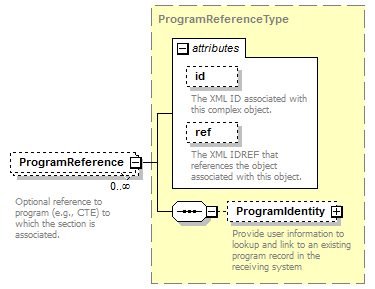 |
||||||||||||||||||||||
| namespace | http://ed-fi.org/0110 | ||||||||||||||||||||||
| type | ProgramReferenceType | ||||||||||||||||||||||
| properties |
|
||||||||||||||||||||||
| children | ProgramIdentity | ||||||||||||||||||||||
| attributes |
|
||||||||||||||||||||||
| annotation |
|
||||||||||||||||||||||
| source | <xs:element name="ProgramReference" type="ProgramReferenceType" minOccurs="0" maxOccurs="unbounded"> <xs:annotation> <xs:documentation>Optional reference to program (e.g., CTE) to which the section is associated.</xs:documentation> </xs:annotation> </xs:element> |
